Abstract
Endoparasitic and predatory nematophagous fungi are widely distributed throughout the maritime Antarctic, being recorded along the Antarctic Peninsula as far south as 68° S. Fungi were recorded from 71% of the sites examined with Cephalosporium balanoides and Dactylaria gracilis being the commonest recorded endoparasite and predator, respectively.
Endoparasites with adhesive and nematode-attracting conidia were shown to be more abundant and to have a competitive advantage in the Antarctic ecosystem over those parasites requiring their conidia to be ingested before infection could occur. Predators able to form traps spontaneously on germination were shown to be far more abundant than those species with a more saprophytic mode of existence, with constricting rings being the most commonly isolated trapping mechanism. Species capturing nematodes by three-dimensional networks were restricted to bird-associated sites indicating that they are able to grow saprophytically in such organically enriched material.
Nematophagous basidiomycetes and phycomycetes were absent except for a single Myzocytium sp. isolated from heated soil.
Similar content being viewed by others
References
Barron, G. L., 1977. The nematode-destroying fungi. Topics in Mycology: 1. Canadian Biological Publications, Guelph, Canada.
Barron, G. L., 1977. Nematophagous fungi: Protascus and its relationship to Myzocytium. Can. J. Bot. 55: 819–824.
Barron, G. L., 1978. Nematophagous fungi: endoparasites in Ontario and their ability to parasitize Rhabditis terricola. Microb. Ecol. 4: 157–163.
Caldwell, J. R., 1981. Biomass and respiration of nematode populations in two moss communities at Signy Island, maritime Antarctic. Oikos 37: 160–166.
Caldwell, J. R., 1981. The Signy Island terrestrial reference sites: XIII. Population dynamics of the nematode fauna. Bull. Br. Antarct. Surv. 54: 33–46.
Capstick, C. K., Twinn, D. C. & Waid, J. S., 1957. Predation of natural populations of free-living nematodes by fungi. Nematologica 2: 193–201.
Cooke, R. C., 1963. Ecological characteristics of nematodetrapping hyphomycetes: I. Preliminary studies. Ann. appl. Biol. 52: 431–437.
Cooke, R. C. & Godfrey, B. E. S., 1964. A key to the nematode-destroying fungi. Trans. Br. mycol. Soc. 47: 61–74.
Dayal, R. & Srivastava, S. S., 1978. Studies in predaceous fungi: V. Some members of hyphomycetes. Proc. Natl. Acad. Sci. India, Ser. B 48: 88–92.
Duddington, C. L., 1951. The ecology of predacious fungi:1. Preliminary survey. Trans. Br. mycol. Soc. 34: 322–331.
Duddington, C. L., 1955. Notes on the technique of handling predacious fungi. Trans. Br. mycol. Soc. 38: 97–103.
Duddington, C. L., Wyborn, C. H. E. & Smith, R. I. L., 1973. Predacious fungi from the Antarctic. Bull. Br. Antarct. Surv. 35: 87–90.
Field, J. I. & Webster, J., 1977. Traps of predacious fungi attract nematodes. Trans. Br. mycol. Soc. 68: 467–469.
Giuma, A. Y. & Cooke, R. C., 1972. Someendozoic parasites on soil nematodes. Trans. Br. mycol. Soc. 59: 213–218.
Gray, N. F., 1984. Ecology of nematophagous fungi: distribution and habitat. Ann. appl. Biol. 102: (in press).
Gray, N. F., 1984. Ecology of nematophagous fungi: isolation and maintenance of predatory and endoparasitic fungi. J. Life Sci., Roy. Dubl. Soc. (in press).
Gray, N. F. & Smith, R. I. L., 1984. Factors affecting distribution in nematophagous fungi in the maritime Antarctic (in preparation).
Gray, N. F., Wyborn, C. H. E. & Smith, R. I. L., 1982. Nematophagous fungi from the maritime Antarctic. Oikos 38: 194–201.
Jansson, H. B., 1982. Attraction of nematodes to endoparasitic nematophagous fungi. Trans. Br. mycol. Soc. 79: 25–29.
Jansson, H. B. & Nordbring-Hertz, B., 1979. Attraction of nematodes to living mycelium of nematophagous fungi. J. Gen. Microbiol. 112: 89–93.
Jansson, H. B. & Nordbring-Hertz, B., 1980. Interactions between nematophagous fungi and plant-parasitic nematodes: attraction, induction of trap formation and capture. Nematologica 26: 383–389.
Longton, R. E. & Holdgate, M. W., 1967. Temperature relationships in Antarctic vegetation. In: A Discussion on the Terrestrial Antarctic Ecosystem (Smith, J. E., ed.). Phil. Trans. R. Soc. 252, Ser. B (777):237–250.
Maslen, N. R., 1982. An unidentified nematode-trapping fungus from a pond on Alexander Island. Bull. Br. Antarct. Surv. 51: 285–287.
Monoson, H. L., Conway, T. D. & Nelson, R. E., 1975. Four endoparasitic nematode-destroying fungi from Sand Ridge State Forest Soil. Mycopathologia 57: 59–62.
Peters, B. G., 1955. A note on simple methods of recovering nematodes from soil. In: Soil Zoology (Kevan, D. K., ed., Proc. Univ. Nottingham, 2nd Easter School of Agriculture Science. Butterworth, London.
Schenck, S., Kendrick, W. B. & Pramer, D., 1977. A new nematode-trapping hyphomyce and a re-evaluation of Dactylaria and Arthrobotrys. Can. J. Bot. 55: 977–985.
Shepherd, A. M., 1956. A short survey of Danish nematophagous fungi. Friesia 5: 396–408.
Spaull, V. W., 1973. The Signy Island terrestrial reference sites: IV. The nematode fauna. Bull. Br. Antarct. Surv. 37: 94–96.
Spaull, V. W., 1973. Qualitative and quantitative distribution of soil nematodes of Signy Island, South Orkney Islands. Bull. Br. Antarct. Surv. 33/34: 177–184.
Spaull, V. W., 1973. Distribution of nematode feeding groups at Signy Island, South Orkney Islands, with an estimate of their biomass and oxygen consumption. Bull. Br. Antarct. Surv. 37: 21–32.
Spaull, V. W., 1973. Distribution of soil nematodes in the maritime Antarctic. Bull. Br. Antarct. Surv. 37: 1–6.
Walton, D.W. H., 1977. Radiation and soil temperatures 1972–74: Signy Island terrestrial reference sites. Data Br. Antarct. Surv. 1: 1–49.
Walton, D. W. H., 1982. The Signy Island terrestrial reference sites: XV. Micro-climate monitoring. Bull. Br. Antarct. Surv. 55: 111–126.
Wood, F. H., 1973. Nematode-trapping fungi from a tussock grassland soil in New Zealand. N.Z.J. Bot. 11: 231–240.
Wyborn, C. H. E., Priest, D. & Duddington, C. L., 1969. Selective technique for the determination of nematophagous fungi in soils. Soil Biol. Biochem. 1: 101–102.
Author information
Authors and Affiliations
Rights and permissions
About this article
Cite this article
Gray, N.F., Lewis Smith, R.I. The distribution of nematophagous fungi in the maritime Antarctic. Mycopathologia 85, 81–92 (1984). https://doi.org/10.1007/BF00436707
Issue Date:
DOI: https://doi.org/10.1007/BF00436707




